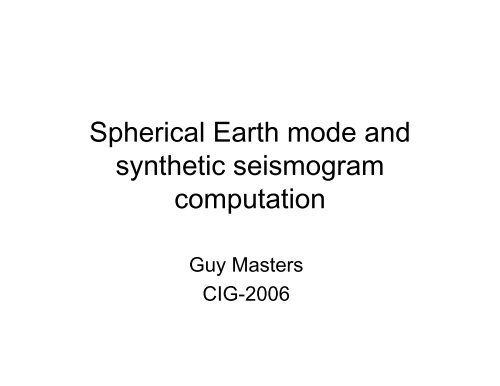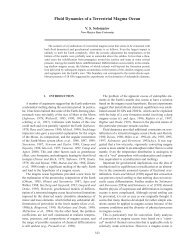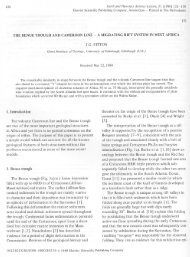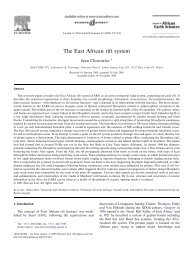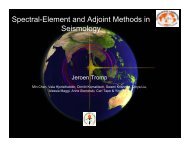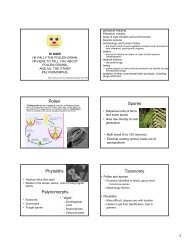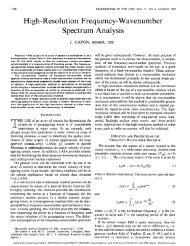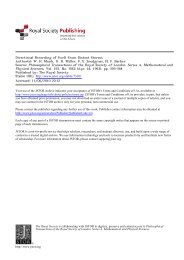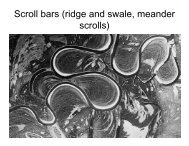Spherical Earth mode and synthetic seismogram computation
Spherical Earth mode and synthetic seismogram computation
Spherical Earth mode and synthetic seismogram computation
You also want an ePaper? Increase the reach of your titles
YUMPU automatically turns print PDFs into web optimized ePapers that Google loves.
<strong>Spherical</strong> <strong>Earth</strong> <strong>mode</strong> <strong>and</strong><strong>synthetic</strong> <strong>seismogram</strong><strong>computation</strong>Guy MastersCIG-2006
MINEOS code package• mineos_bran: does <strong>mode</strong> eigenfrequency<strong>and</strong> eigenfunction calculation -- this is whereall the work is!• eigcon: massages eigenfunctions for greensfunction calculation• green: computes greens functions for a pointsource• syndat: makes <strong>synthetic</strong>s for double-coupleor moment tensor sources
Some background on <strong>mode</strong>s
Seismogram is a sum of decaying cosinusoids
SpheroidalRadialToroidal
Can <strong>mode</strong>l real dataBolivia, T>120 sec
Complete <strong>synthetic</strong>s -- includes diffraction etc.SH, T>5secDistanceReduced time
Basic equations(now for the fun stuff!)
Constitutive relationship
Toroidal <strong>mode</strong>s
(W is scalar for displacement, T is scalar for traction)Note that matrix does not depend on m
Algorithm for toroidal <strong>mode</strong>s• Choose harmonic degree <strong>and</strong> frequency• Compute starting solution for (W,T)• Integrate equations to top of solid region• Is T(surface)=0? No: go changefrequency <strong>and</strong> start again. Yes: we havea <strong>mode</strong> solution
T(surface) for harmonic degree 1
(black dots are observed <strong>mode</strong>s)
(black dots are observed <strong>mode</strong>s)
Complete <strong>synthetic</strong>s -- includes diffraction etc.SH, T>5secDistanceReduced time
Radial <strong>and</strong> Spheroidal <strong>mode</strong>s
Only 14 distinct non-zero elements of A
(Solution follows that of toroidal <strong>mode</strong>s)
(gravity term corresponds to a frequency of about 0.4mHz)
Spheroidal <strong>mode</strong>s
Minors (at last)• To simplify matters, we will consider thespheroidal <strong>mode</strong> equations in theCowling approximation where weinclude all buoyancy terms but ignoreperturbations to the gravitationalpotential
Spheroidal <strong>mode</strong>s w/ self grav(three times slower than for Cowling approx)
(black dots are observed <strong>mode</strong>s)
Red > 1%; green .1--1%; blue .01--.1%
Red>5; green 1--5; blue .1--1 microHz
Mode energy densities
Normalized radiusDash=shear, solid=compressional energy density
(black dots are observed <strong>mode</strong>s)
All <strong>mode</strong>s for l=1
(normal normal <strong>mode</strong>s)
hard to computeScS --not observed(not-so-normal normal <strong>mode</strong>s)
Another problem• Stoneley <strong>and</strong> IC <strong>mode</strong>s have part of theireigenfunctions which decay exponentiallytowards the surface• As your mother told you, NEVER integratedown an exponential!!• For these <strong>mode</strong>s, need to do anotherintegration from surface to CMB or ICB to getfinal eigenfunction (remedy)
H<strong>and</strong>ling attenuation(perturbation theory)
Beware!• The attenuation rate of the <strong>mode</strong>, its groupvelocity (found by varying harmonic degree)<strong>and</strong> the kinetic <strong>and</strong> potential energies are allfound by performing numerical integrals usingGauss-Legendre. The <strong>mode</strong> eigenfunctionsare approximated by cubic polynomialsbetween <strong>mode</strong> knots.• If you have insufficient knots in your <strong>mode</strong>l,these integrals will be imprecise• Check the output to make sure you are ok
Some final comments• Many things can go wrong in a <strong>mode</strong>calculation <strong>and</strong> this code has been designedto avoid or fix most of them• You can still break it. For example, if youwork at high frequencies <strong>and</strong> your <strong>mode</strong>l hasan ocean, you can get Stoneley <strong>mode</strong>strapped on the ocean floor. The code couldbe adapted to h<strong>and</strong>le this• Other versions of the code exist to h<strong>and</strong>lehigh frequencies -- these may beimplemented in CIG eventually• Other versions have also been designed toread an observed <strong>mode</strong> list for use in doing1D reference <strong>Earth</strong> <strong>mode</strong>ling
A few words about <strong>synthetic</strong>s


